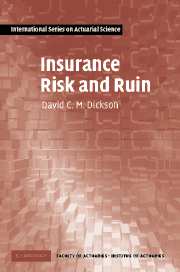Book contents
- Frontmatter
- Contents
- Preface
- 1 Probability distributions and insurance applications
- 2 Utility theory
- 3 Principles of premium calculation
- 4 The collective risk model
- 5 The individual risk model
- 6 Introduction to ruin theory
- 7 Classical ruin theory
- 8 Advanced ruin theory
- 9 Reinsurance
- References
- Solution to exercises
- Index
8 - Advanced ruin theory
Published online by Cambridge University Press: 19 January 2010
- Frontmatter
- Contents
- Preface
- 1 Probability distributions and insurance applications
- 2 Utility theory
- 3 Principles of premium calculation
- 4 The collective risk model
- 5 The individual risk model
- 6 Introduction to ruin theory
- 7 Classical ruin theory
- 8 Advanced ruin theory
- 9 Reinsurance
- References
- Solution to exercises
- Index
Summary
Introduction
In this chapter we continue our study of the classical risk model. We start with a useful result concerning the probability that ruin occurs without the surplus process first attaining a specified level. This result will be applied in Sections 8.4 and 8.5 and Exercise 9. We then consider the insurer's deficit when ruin occurs and provide a means of finding the distribution of this deficit. We extend this study by considering the insurer's largest deficit before the surplus process recovers to level 0. Following this, we consider the distribution of the insurer's surplus immediately prior to ruin. We then consider the distribution of the time to ruin, and conclude with a discussion of a problem which involves modifying the surplus process through the payment of dividends.
In this chapter we use the same assumptions and notation as in Chapter 7.
A barrier problem
Let us consider the following question: what is the probability that ruin occurs from initial surplus u without the surplus process reaching level b > u prior to ruin? An alternative way of expressing this question is to ask what is the probability that ruin occurs in the presence of an absorbing barrier at b? We denote this probability by ξ(u, b), and let χ(u, b) denote the probability that the surplus process attains the level b from initial surplus u without first falling below zero.
- Type
- Chapter
- Information
- Insurance Risk and Ruin , pp. 157 - 189Publisher: Cambridge University PressPrint publication year: 2005



